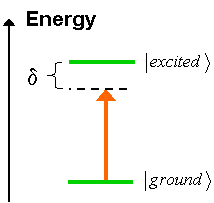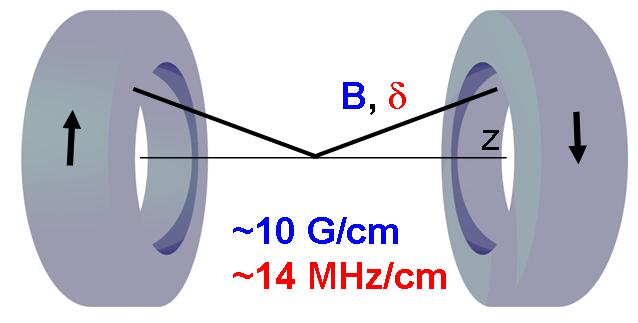|
Basic MOT Physics
The MOT slows down background gas atoms
primarily through the mechanism of Doppler cooling. The MOT traps the cold
atoms by increasing the strength of the Doppler cooling force as an atom moves
away from the magnetic field zero.
 Doppler Cooling
Doppler Cooling
We consider a two-level atom with a ground
state and an excited state, as depicted in the
figure on the right. We adjust a laser so that its energy, or
frequency, is slightly less than the energy of the atomic
ground-to-excited transition. The atom will absorb and randomly
re-emit photons from the laser beam more frequently as the energy of the laser
gets closer to the energy of the ground-to-excited transition.
If we shine two such counter-propagating laser
beams on a moving atom, then in the lab frame we have the
following situation:

In the lab frame the difference between the atomic
transition energy and the laser energy, or frequency, is d.
In the frame of the moving atom, the atom sees each of the
counter-propagating lasers at a different energy, due to the Doppler effect.
The atoms sees the laser beam it is travelling towards with a higher
frequency (blue shifted), closer to the ground-to-excited
transition, while it sees the laser beam it is travelling away
from with a lower frequency (red shifted), further from
the ground-to-excited transition.

Consequently, the atom absorbs (and re-emits) more
photons from the laser beam it is travelling towards and less from
one which it is moving away.
With each photon absorption and re-emission event, the atom gets a
little recoil velocity/momentum kick in the direction of the
laser beam from which it absorbed the photon. Since the atom tends to scatter
more photons from the beam it is travelling towards, then on average the
atom slows.

While each kick is not very large, just 6 mm/s
in the case of 87Rb, this force produces a massive
decceleration, since there are typically 107 scattering events
per second. The strength of the Doppler force depends on the
velocity of the atom, and has the following velocity dependence for 87Rb:

While the plot shows the force operating down to a
zero velocity, Doppler cooling cannot reduce an atom's velocity to zero. The
random photon re-emission associated with each absorption process acts to
counteract Doppler cooling and limits the final attainable temperature, the
Doppler temperature. In the case of 87Rb, this
minimum velocity is about 10 cm/s, which corresponds to a
temperature of about 180 mK.
Trapping
 Doppler cooling affects only the velocity of the atoms. Once the atoms have
been cooled to the Doppler temperature, they are free to diffuse around at
their Doppler velocity. The addition of spatially dependent magnetic field
changes the energy of the atom's ground-to-excited transition through the Zeeman
effect. If the magnetic field strength increases away from the
center of the quadrupole coil pair, then the energy of the atomic
ground-to-excited transition will decrease (if the atom is optically pumped
into the correct magnetic substate), approaching that of the laser. A judicious
choice of laser polarization guarantees that the atom will
tend to absorb more photons from the laser beam it is closer too (with respect
to the magnetic field zero): this creates a restoring force back towards
the magnetic field zero.
Doppler cooling affects only the velocity of the atoms. Once the atoms have
been cooled to the Doppler temperature, they are free to diffuse around at
their Doppler velocity. The addition of spatially dependent magnetic field
changes the energy of the atom's ground-to-excited transition through the Zeeman
effect. If the magnetic field strength increases away from the
center of the quadrupole coil pair, then the energy of the atomic
ground-to-excited transition will decrease (if the atom is optically pumped
into the correct magnetic substate), approaching that of the laser. A judicious
choice of laser polarization guarantees that the atom will
tend to absorb more photons from the laser beam it is closer too (with respect
to the magnetic field zero): this creates a restoring force back towards
the magnetic field zero.
|
